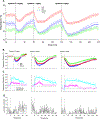Xylazine effects on opioid-induced brain hypoxia
- PMID: 37340247
- PMCID: PMC10775769
- DOI: 10.1007/s00213-023-06390-y
Xylazine effects on opioid-induced brain hypoxia
Abstract
Rationale: Xylazine has emerged in recent years as an adulterant in an increasing number of opioid-positive overdose deaths in the United States. Although its exact role in opioid-induced overdose deaths is largely unknown, xylazine is known to depress vital functions and cause hypotension, bradycardia, hypothermia, and respiratory depression.
Objectives: In this study, we examined the brain-specific hypothermic and hypoxic effects of xylazine and its mixtures with fentanyl and heroin in freely moving rats.
Results: In the temperature experiment, we found that intravenous xylazine at low, human-relevant doses (0.33, 1.0, 3.0 mg/kg) dose-dependently decreases locomotor activity and induces modest but prolonged brain and body hypothermia. In the electrochemical experiment, we found that xylazine at the same doses dose-dependently decreases nucleus accumbens oxygenation. In contrast to relatively weak and prolonged decreases induced by xylazine, intravenous fentanyl (20 μg/kg) and heroin (600 μg/kg) induce stronger biphasic brain oxygen responses, with the initial rapid and strong decrease, resulting from respiratory depression, followed by a slower, more prolonged increase reflecting a post-hypoxic compensatory phase, with fentanyl acting much quicker than heroin. The xylazine-fentanyl mixture eliminated the hyperoxic phase of oxygen response and prolonged brain hypoxia, suggesting xylazine-induced attenuation of the brain's compensatory mechanisms to counteract brain hypoxia. The xylazine-heroin mixture strongly potentiated the initial oxygen decrease, and the pattern lacked the hyperoxic portion of the biphasic oxygen response, suggesting more robust and prolonged brain hypoxia.
Conclusions: These findings suggest that xylazine exacerbates the life-threatening effects of opioids, proposing worsened brain hypoxia as the mechanism contributing to xylazine-positive opioid-overdose deaths.
Keywords: Brain hyperoxia; Brain hypoxia; Cerebral vasoconstriction; Fentanyl; Heroin; Hypothermia; Peripheral vasodilation.
© 2023. This is a U.S. Government work and not under copyright protection in the US; foreign copyright protection may apply.
Conflict of interest statement
Figures





Similar articles
-
Brain oxygen responses induced by opioids: focus on heroin, fentanyl, and their adulterants.Front Psychiatry. 2024 Jan 17;15:1354722. doi: 10.3389/fpsyt.2024.1354722. eCollection 2024. Front Psychiatry. 2024. PMID: 38299188 Free PMC article. Review.
-
Heroin Contaminated with Fentanyl Dramatically Enhances Brain Hypoxia and Induces Brain Hypothermia.eNeuro. 2017 Oct 30;4(5):ENEURO.0323-17.2017. doi: 10.1523/ENEURO.0323-17.2017. eCollection 2017 Sep-Oct. eNeuro. 2017. PMID: 29085909 Free PMC article.
-
Combined treatment with naloxone and the alpha2 adrenoceptor antagonist atipamezole reversed brain hypoxia induced by a fentanyl-xylazine mixture in a rat model.Neuropsychopharmacology. 2024 Jun;49(7):1104-1112. doi: 10.1038/s41386-023-01782-2. Epub 2023 Dec 20. Neuropsychopharmacology. 2024. PMID: 38123817 Free PMC article.
-
Respiratory depression and brain hypoxia induced by opioid drugs: Morphine, oxycodone, heroin, and fentanyl.Neuropharmacology. 2019 Jun;151:219-226. doi: 10.1016/j.neuropharm.2019.02.008. Epub 2019 Feb 5. Neuropharmacology. 2019. PMID: 30735692 Free PMC article. Review.
-
Fentanyl-Induced Brain Hypoxia Triggers Brain Hyperglycemia and Biphasic Changes in Brain Temperature.Neuropsychopharmacology. 2018 Mar;43(4):810-819. doi: 10.1038/npp.2017.181. Epub 2017 Aug 29. Neuropsychopharmacology. 2018. PMID: 28849778 Free PMC article.
Cited by
-
Targeting α1- and α2-adrenergic receptors as a countermeasure for fentanyl-induced locomotor and ventilatory depression.Environ Toxicol Pharmacol. 2024 Sep;110:104527. doi: 10.1016/j.etap.2024.104527. Epub 2024 Aug 4. Environ Toxicol Pharmacol. 2024. PMID: 39106924
-
Brain oxygen responses induced by opioids: focus on heroin, fentanyl, and their adulterants.Front Psychiatry. 2024 Jan 17;15:1354722. doi: 10.3389/fpsyt.2024.1354722. eCollection 2024. Front Psychiatry. 2024. PMID: 38299188 Free PMC article. Review.
-
The xylazine-fentanyl nexus: A public health emergency.SAGE Open Med. 2025 Jun 19;13:20503121251348068. doi: 10.1177/20503121251348068. eCollection 2025. SAGE Open Med. 2025. PMID: 40546932 Free PMC article. Review.
-
Impacts of xylazine on fentanyl demand, body weight, and acute withdrawal in rats: A comparison to lofexidine.Neuropharmacology. 2024 Mar 1;245:109816. doi: 10.1016/j.neuropharm.2023.109816. Epub 2023 Dec 20. Neuropharmacology. 2024. PMID: 38128606 Free PMC article.
-
Providers' knowledge and perception of xylazine in the unregulated drug supply: a sequential explanatory mixed-methods study.Harm Reduct J. 2024 Aug 16;21(1):148. doi: 10.1186/s12954-024-01052-4. Harm Reduct J. 2024. PMID: 39148036 Free PMC article.
References
-
- Bolger FB, Bennett R, Lowry JP. An in vitro characterization comparing carbon paste and Pt microelectrodes for real-time detection of brain tissue oxygen. Analyst. 2011; 136(19):4028–35. - PubMed
-
- Brown JH, Pleuvry BJ. Antagonism of the respiratory effects of alfentanil and fentanyl by naloxone in the conscious rabbit. Br J Anaesth. 1981; 53(10):1033–7. - PubMed
MeSH terms
Substances
Grants and funding
LinkOut - more resources
Full Text Sources
Medical

